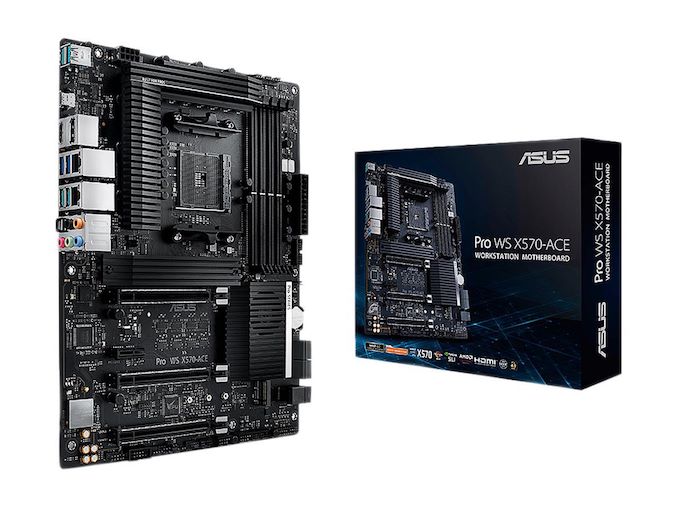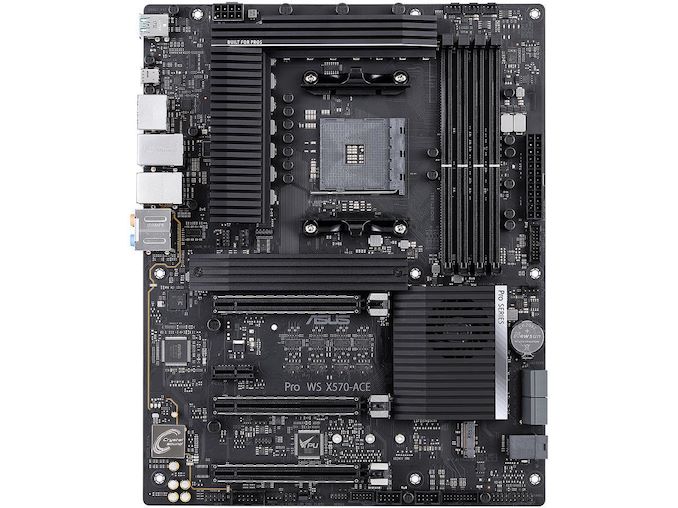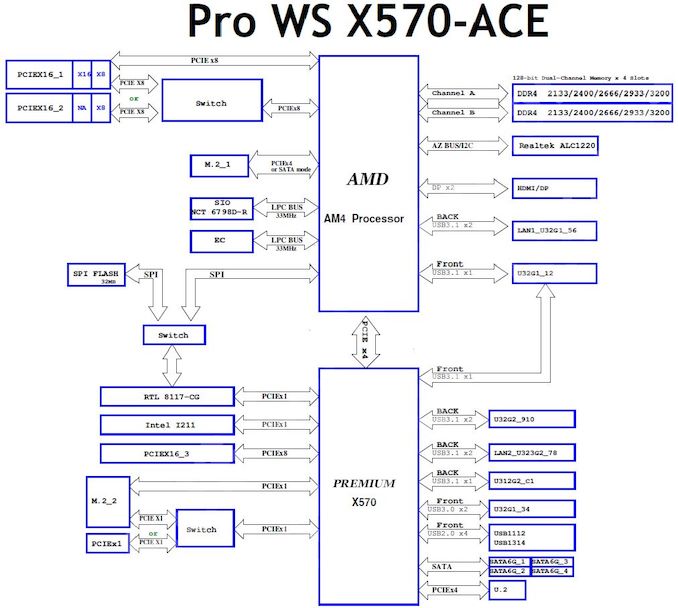The ASUS Pro WS X570-Ace Review: x8x8x8 with No RGB
by Gavin Bonshor on August 12, 2019 9:00 AM EST
Not all motherboards are created equal, and some come with different distinguishing features which amplify them above the others. Whether that be gaming or professional use, the ASUS Pro WS X570-Ace as it stands is the only X570 model which is focused on the professional market with official support for ECC memory, three full-length PCIe 4.0 slots which operate at x16, x8/x8, and is the only current X570 model to operate at x8/x8/x8 across all of its slots, using a full x8 connection from the chipset.
ASUS Pro WS X570-Ace Overview
The ASUS Pro WS X570-Ace is the only X570 motherboard designed and focused around the professional market and as a result, drops all the gaming branding and gaming focused extras. There are no integrated RGB LEDs - instead the ASUS Pro WS X570-Ace focuses on a sleek look with an all-black design and horizontally finned black aluminium heatsinks. Underneath the heatsinks is a 12+2 phase power delivery spearheaded by an ASP1405I controller operating in a 6+2 configuration. ASUS has focused more on transient response and has appropriately opted to team the phases together instead of using doublers. The end result is still a 12-phase design, done in a way to align with the intended workflow of a professional system.
One of the key elements to this board design is the x8/x8/x8 PCIe 4.0 slot layout. This motherboard is the only one on the market that uses a full PCIe 4.0 x8 lane available from the AMD X570 chipset, enabling an array of different use cases that ASUS believes this market needs. Technically the upstream link to the CPU is still limited to PCIe 4.0 x4, however this does enable PCIe 3.0 x8 cards to have full bandwidth, which accounts for a lot of add in cards (RAID, high-end networking).
ASUS Pro WS X570-Ace Block Diagram
One of the major upheavals for AMD on the new 7 nm manufacturing process is in its memory performance. Back in 2017 when the first generation of AMD's AM4 X370 models launched, there was a lot of focus on its memory support and with launch day firmware, a lot of issues arose in the compatibility of memory kits rated above DDR4-3200. Now while X570 is still on the AM4 socket, major advancements have been made with the strength of the IPC onboard the Ryzen 3000 series of processors and as also memory support is much improved. The ASUS Pro WS X570-Ace has four memory slots with support for up to DDR4-4400 and up to 128 GB. A lot of speculation has been made with manufacturers mentioning support for ECC memory, but the ASUS Pro WS X570-Ace has full support for ECC and includes options for scrubbing within the firmware; this comes down to processor support, but the WS X570-Ace is certainly geared for it.
Looking at the feature set of the ASUS Pro WS X570-Ace, networking is handled by a pair of Gigabit NICs and the onboard audio is controlled by a Realtek ALC1200S with an integrated EMI shield which offers five 3.5 mm audio jacks and S/PDIF optical output on the rear panel, and the front panel audio connector located in the bottom left-hand corner of the board. Looking at the rest of the rear panel inputs, ASUS has gone with four USB 3.1 G2 Type-A, one USB 3.1 G2 Type-C, and two USB 3.1 G1 Type-A ports. Moving onto the storage options on offer and the ASUS Pro WS X570-Ace has plenty to shout about with two PCIe 4.0 M.2 slots (x4/x2), with four SATA ports that support RAID 0, 1, and 10 arrays.
The overall performance displayed by the ASUS Pro WS X570-Ace is positive in multiple areas of our system, CPU, and gaming test suites. In terms of power consumption, there wasn't too much difference between the long idle and idle power states. The workstation-focused WS X570-Ace did, however, display the lowest power draw at full load over both the MSI MEG X570 Godlike and MEG X570 Ace by around 7 Watts. Testing POST times also threw up some interesting results at default settings with a rather long POST time of 33 seconds; we managed to shrink this by nearly 13 seconds when we turned all the non-vital controllers off including onboard audio and networking; this is over a third of the POST time which shows the ASUS Pro WS X570-Ace to have a little bit of inefficiency when booting into Windows 10.
Moving onto the overclocking performance, and the ASUS Pro WS X570-Ace performed very well all things considered, and although this model isn't aimed at enthusiasts and gamers, it still packs a mighty punch with its 12+2 phase power delivery. The single 8-pin 12 V ATX CPU power input didn't hinder our testing in the slightest and we managed to hit the wall of our Ryzen 7 3700X processor which currently sits at 4.3 GHz at 1.375 V. CPU VCore voltage VDroop wasn't an issue and it was found to be stable at all of the frequencies and CPU VCore settings we set it to. At full load when the processor needed the grunt, the power delivery proved effective in boosting the CPU VCore when it was needed, which in turn not only reduces power consumption but temperatures too. AMD's Precision Boost Overdrive settings also proved fruitful on this model with a respectable gain in performance in our POV-Ray benchmark; the ASUS Pro WS X570-Ace is the first model we've tested so far to show an effective gain with PBO.
The ASUS Pro WS X570-Ace currently sits as the only workstation focused motherboard in the current product stack, and includes a good range of features for consumers and professional users. The X570 chipset isn't specifically designed for workstation situations, and includes features such as ASUS Node, which enables ASUS' partners to develop products with an OLED display (for example, InWin has a case that supports it).
With a current retail price of $380 at Newegg in the US, the ASUS Pro WS X570-Ace stands out from a very crowded gaming-orientated X570 product stack and while omitting features such as RGB LEDs, it is sure to prove popular with consumers who hate the thought of a wild rainbow discotheque startling their vision. The official support with compatible Ryzen 2000 and 3000 Pro for ECC memory also make this an interesting and appealing option to consider.













110 Comments
View All Comments
umano - Wednesday, August 14, 2019 - link
It seems a great mb and it has a wonderful look. It is not the board for me, I'd go HEDT with an Atx board, but I like the approach based on quality, caring about details that do not shine on paper or on images but they shine on performance, reliability and why not pleasure to use. The shield and separation for the audio it is a needed touch of design elegance.I really hope this is not the last we heard from x570 boards, to me the x570 offer lacks an outstanding pro oriented Itx board.
FredeBR - Wednesday, August 14, 2019 - link
I saw comments that 3900x works very hot (high temperature). On this asus board is it possible to configure processor downclock, like lowering the cpu voltage? I will use for full load processing for more than 24 hours in a row.TheinsanegamerN - Thursday, August 22, 2019 - link
The 3900x is a 12 core CPU. It's goona need some big boy cooling. If you dont want to deal with the heat you should probably stick with an 8 core ryzen. You could turn off turbo boost, but then why bother shelling out more for the big chips if youre just gonna kneecap it?abufrejoval - Thursday, August 15, 2019 - link
As much as I like the 3x8 general option, it pains me that the first logical addition to a GPU and perhaps a RAID controller, 10GBase-T Ethernet is going to swallow 8 lanes of PCIe 4, while a single lane would be quite sufficient and actually the Ethernet IP block for that is already supposed to be inside the 'chipset'! And that price, whatever licence cost required to make use of it, should be included.Otherwise it looks like one of the sanest mainboard designs I have seen so far.
alpha754293 - Thursday, August 15, 2019 - link
"One of the key elements to this board design is the x8/x8/x8 PCIe 4.0 slot layout. This motherboard is the only one on the market that uses a full PCIe 4.0 x8 lane available from the AMD X570 chipset, enabling an array of different use cases that ASUS believes this market needs. Technically the upstream link to the CPU is still limited to PCIe 4.0 x4, however this does enable PCIe 3.0 x8 cards to have full bandwidth, which accounts for a lot of add in cards (RAID, high-end networking)."This is quite possibly one of the worst boards on the market then.
They have three PCIe 4.0 x16 physical slots, but either only run at its native x16 speeds if you only have one card installed, x8 if you have two, and really x8/x8/**x4** if you have three cards installed since the chipset to CPU interface is a PCIe 4.0 **x4** link.
That is so dumb.
Why would they bother putting in a x16 physical slot, and then because of the chipset link, only run it at x4 electrically?
Quite possibly one of the worst product development/engineering decisions ever.
A single NVMe PCIe 4.0 x4 SSD would be able to consume all of that bandwidth.
moriz - Friday, August 16, 2019 - link
i think the key here is that the third slot can *supposedly run at PCIe **3.0** x8, which allows it to give full bandwidth to any PCIe 3.0 x8 add-in card.*supposedly, because i've yet to see any confirmation that it is capable of doing the PCIe version switch.
YaroslavZ - Sunday, August 18, 2019 - link
hey! , I bought this mobo a couple of days ago, I bought it because I wanted to upgrade my old cpu to R9 3900X, I also happened to have 4 R9 390 gpus (2 390s 2 390x) , sadly I don't have the cpu yet, I do have the r5 1400 lying around but I don't feel like taking it out from completely different cpu and adding it into that costly mobo just to test things out,I bought that mobo exactly to run 4way CFX with these gpus, 8x 8x 4+4x* & 4x from m.2 to pcie adapter,
based on your words, in theory the 3rd slot should be able to use more bandwidth than a simple 4x 3.0 , is that correct? if so then that will pretty good upgrade over a simple 4x.
anyways just to give you some info, a simple 4x 3.0 uses around 70~75% power of R9 390, while 8x around 99% ,
I do know that because atm i'm sitting through 8x 8x 4x in asus z170-a , which also have m.2 at x4 so 4way is possible as well but I bought the adapter just recently and I don't really want to sit through sata ssd, as well as this mobo currently have problems with 2 ram slots because of which I can't use dual channel atm, which obviously makes 3gpus to barely outperform a single gpu so adding 4th on top of that is pointless, wish the prices on r9 3900x will fall soon.
here is stock 3way (8x 8x 4x) 3dmark (firestrike ultra) score in dual channel when I still had it, also, R9 390X performing with stream processors of R9 390's if I got it right(aka it's like 3x of R9 390 even when some of them have X's), because I was forced to use R9 390 as gpu1 to enable CFX,, https://www.3dmark.com/fs/18192586
tristank - Tuesday, August 20, 2019 - link
How does this even works? Is there some kind of translation between PCIe 4.0 x4 to PCIe 3.0 x8. I dont get it. I thought this was not possible.JKJK - Friday, August 16, 2019 - link
A card like this without 10GbE is completely idiotic.You shouldn't have to waste a pci-e port on it. And it should be intel. Let the gamers use the unstable Aquantica shit chips and drivers (been there, done that).
Tomyknee - Sunday, September 1, 2019 - link
All I hear about is the chipset fan. I have read (Buildazoid in May 2019 Gig Master review) that it is the RAID setups going through the Chipset that sets the fan off. Unfortunately the second M.2 is only PCIe x2. Other than SATA drives maxed at 6gbs, it does not make sense to run RAIDO for speed. Samsung will have PCIe 4.0 NVMe M.2 that surpase 7gbs R/W within a year and the 2x will not take advantage of that.A deal breaker for me, (I really like this board, really want to order it - looks great and no RGB!)